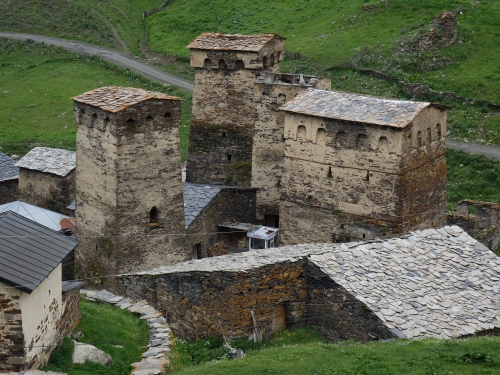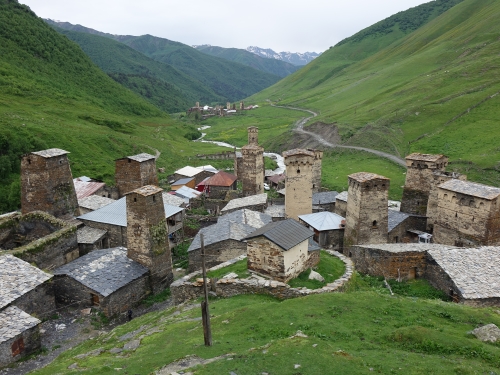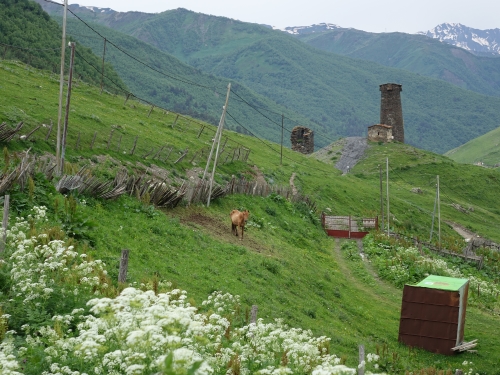Blog WHS Visits
WHS #663: Upper Svaneti
Upper Svaneti is among the most remote WHS in Europe, and one that has been on my travel wish list for long. It was a fairly dangerous place until 2003, “when robbing the foreign visitors were almost a daily thing”. Since then it has arrived slowly on the beaten tourist track. The road to get there is steadily improving as well: it took me 2.5 hours from Zugdidi to Mestia, and another 2 hours to cover the final 44km from Mestia to the Ushguli valley with the WHS (full-size marshrutka’s still take longer than the shared jeep-taxi’s which I took). I stayed for 3 nights in the Svaneti capital of Mestia, a lively town similar to a ski resort.

At the central square of Mestia, jeeps and minibuses congregate daily to take tourists on a trip to Ushguli. The asking price for a spot in a jeep for a return trip is 50 lari (17 EUR), a private car costs 200 lari. I did not want to wait for a jeep to fill up, so I splurged on the private option. The road still needs a 4WD because of the many potholes that fill up with rain water, and the muddy state of it all. We did encounter some brave cycling tourists along the way however. The surrounding landscape is just beautiful: narrow, green valleys with high peaks on either side which still hold a lot of snow. This area has the highest mountains in Georgia, including the Shchara (5201 meters).
Along the way we already passed many villages with the characteristic Svaneti tower houses, also Mestia still has a lot of them. Despite its grand name, the Upper Svaneti WHS has a ridiculously small core zone. In the Ushguli valley there are 4 villages or hamlets dominated by tower houses, but of those only Chazhashi has been inscribed as it was already under some form of protection. According to the UNESCO description, it “has preserved more than 200 medieval tower houses, churches and castles.“ Well – this is really not true! As you can see from my second photo, it has only some 25 buildings (28 people live there according to the 2014 census).

In Chazhashi the tower houses are close together, and no modern buildings have been constructed among them. The streets are unpaved, and slippery due to a combination of mud and cow manure. The special feature of the tower houses is that the upper floors were used as watchtowers, and on the bottom floor the people and their animals lived together. These animals are still trampling through the streets: pigs, dogs, cows. Young ‘cowboys’ tend to the cows on horseback.
On the other side of the river there are 2 more villages: Chvibiani and Zhibiani. These are more picturesque than Chazhashi at first glance: especially because they have the snowy white mountains as their backdrop. But there are more modern buildings standing between the residential towers here. These villages hold two tiny churches and a museum, but I found everything closed on a Monday. Finally my driver pointed me to a path uphill. Here you end up at the remains of the Tower of Queen Tamar. This supposedly was the place where the population gathered during the Middle Ages to discuss the battle plans. Here the fortress walls were once the strongest, but in the 1930s much was destroyed by the Soviets. Now it is mainly a beautiful viewpoint over the villages and their towers.

A trip to the core zone should be complemented by a visit to the modern Svaneti museum in Mestia and a look into the interior of a Svaneti tower house. The museum’s highlight is a room full of icons, taken from the villages around Mestia. They have been painted in the naïve Svan-style. In Mestia as well there are 2 tower houses open to visitors. I visited the Mikhail Khergiani house, a tribute to a local mountain climber. In its main room on the first floor it can be seen how animals and humans shared the living spaces, to keep warm during the very cold winter nights. Via two ladders I climbed the tower itself – only at the top there are openings to get a 360 degree view of the surroundings.
Els - 27 June 2018